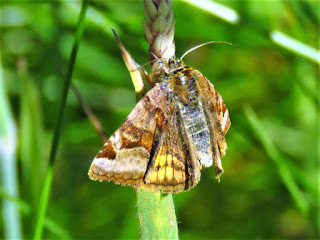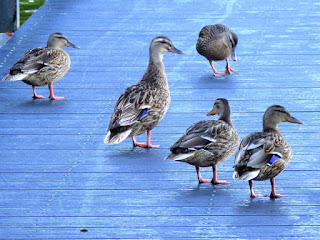Priorslee Lake: 04:10 – 05:40 // 06:45 – 09:55
[Woodhouse Lane: 07:25 – 08:20]
The Flash: 05:45 – 06:40
10.0°C > 17.0°C: Wall to wall blue sky until a very few puffy clouds developed after 09:30. Light NNW wind. Very good visibility
Sunrise: 04:51 BST
Priorslee Lake: 04:10 – 05:40 // 06:45 – 09:55
(166th visit of the year)
Bird notes from today
- a new brood of just two small Mallard ducklings
- Apparently a different pair of Tufted Ducks, the drake with much whiter flanks: flew off.
- Just the two long-term resident pairs of Great Crested Grebes noted. The pair in the NW area seemed to have only one juvenile, though they stayed in / close-to the reeds most of the time and it was hard to be certain.
- Even the most enthusiastic Coots have stopped refurbishing nests and so I assume we will get no more broods of juveniles. All the juveniles extant (33?) seem out of danger and if all make it to adulthood this will have been an exceptional breeding season – perhaps because with fewer pairs there was less fighting?
- An adult Black-headed Gull dropped in at 04:50 but had gone by 05:00. Two birds – and adult and a first-summer – were present by 07:00 with the adult staying until 08:50 when it left to join two passing adults.
- The ’10 large gull sp.’ all flew through before 04:40 and against the sunrise identifying which species was not feasible.
- A Yellow Wagtail was heard calling at c.09:30 but I could not find it.
Bird totals:
Birds noted flying over or flying near the lake:
- 3 Cormorants
- 1 Grey Heron
- 2 adult Black-headed Gulls
- 10 large gull sp.
- 3 Stock Doves
- 26 Wood Pigeons
- 48 Jackdaws
- 74 Rooks
Hirundines etc. noted:
- c.20 Swifts
- 4 Barn Swallows again
- 4 House Martins
Warblers noted (singing birds):
- 10 (7) Chiffchaffs
- 16 (12) Blackcaps
- 1 (1) Garden Warbler again
- 5 (2) (Common) Whitethroats
- 1 (1) Sedge Warbler still
- 6 (5) Reed Warblers
Counts from the lake area:
- 2 + 6 (1 brood) Mute Swans as ever
- 16 (14♂) + 2 (1 brood) Mallard
- 2 (1♂) Tufted Duck
- Little Grebe(s) heard once more
- 4 + 3? (2 broods) Great Crested Grebes
- 3 + 3 (2 broods) Moorhens
- 29 + 33 (? broods) Coots
- 3 Black-headed Gulls
Nothing on the lamp poles pre-dawn.
Seen later:
- 1 noctule-type bat
The following insects logged
- Butterflies (in species order):
- >10 Large Skipper (Ochlodes sylvanus)
- 2 Speckled Wood (Pararge aegeria)
- >25 Ringlet (Aphantopus hyperantus)
- 3 Meadow Brown (Maniola jurtina)
- 1 Red Admiral (Vanessa atalanta): new for me here in 2019
- 1 Small Tortoiseshell (Aglais urticae)
- 1 Comma (Polygonia c-album)
- Moths (in species order):
- 1 Yellow-barred Longhorn (Nemophora degeerella)
- the same (?) 3 Narrow-bordered Five-spot Burnets (Zygaena lonicerae) as Monday
- >10 Garden Grass-veneers (Chrysoteuchia culmella)
- 1 Burnet Companion (Euclidia glyphica): moth species #35 here in 2019
- Damselflies etc. (alphabetic order of vernacular name):
As usual
- Azure Damselflies
- Blue-tailed Damselflies
- Common Blue Damselflies
Also
- 2 unidentified dragonflies of different species flushed
- The usual hoverfly suspects were not investigated: no unusual species noted
And other things:
- just 2 larvae of Harlequin Ladybirds (Harmonia axyridis) after the excesses of yesterday
- 3 Honey Bees (Apis mellifera)
- several ichneumon (wasp), all apparently the same species as yesterday, and perhaps Ichneumon suspiciosus
- a few Black Snipe flies (Chrysopilus cristatus)
- very many Mystacides longicornis (caddis flies) dancing over the waterside vegetation
A bit like #11 buses. Days without any decent sightings and now Long-tailed Tits line up for photos.
This rather soggy from the dew and at the first hint of sun on top of bushes to dry out and warm up.
How could I resist?
Again ...?
.... and again!
And even two together.
I have had a rethink about these forget-me-nots ....
Looking at the leaf, here, I now believe them to be, as I suspected, Water Forget-me-not (Myositis palustris).
(Ed Wilson)
------------------------------------------------------------------------------------------------------
Notes from Woodhouse Lane (07:25 – 08:20)
(21st visit of the year)
Notes from here:
- Three Barn Swallows hunting over the fields was unusual
- The Yellow Wagtail came out of a field alongside the lane
- No Linnets a bit of a disappointment
- Reed Bunting singing in same field as the Yellow Wagtail
also
- >5 Ringlet butterflies (Aphantopus hyperantus)
- 1 Red Admiral butterfly (Vanessa atalanta)
- 1 Painted Lady butterfly (Vanessa cardui)
- 1 Harlequin Ladybird adult (Harmonia axyridis)
- 1 Spotted Cranefly (Nephrotoma appendiculata)
plus
- many many hoverflies of all the usual suspects
surprisingly, even near the Wesley Brook at the sluice
- no damselflies
Totals of ‘interesting’ species (singing birds)
- 1 (1) Pheasant
- 1 Great Spotted Woodpecker
- 2 (1) Skylarks
- 3 Barn Swallows
- 1 party of Long-tailed Tits
- 3 (2) Chiffchaffs
- 3 (3) Blackcaps
- 2 (1) (Common) Whitethroats
- 1 (1) Song Thrushes
- 1 Yellow Wagtail
- 1 Pied Wagtail
- 3 (1) Chaffinches
- 2 (1) Greenfinch
- 2 Goldfinches
- 6 (4) Yellowhammers
- 1 (1) Reed Bunting
A Red Admiral butterfly (Vanessa atalanta) of course. Looks like it has been in a few fights.
This looks a bit like the Tiger Cranefly (Nephrotoma flavescens) I photographed at the lake but it is slightly larger and has a mark in the wing making it a Spotted Cranefly (Nephrotoma appendiculata).
A close-up.
(Ed Wilson)
------------------------------------------------------------------------------------------------------
The Flash: 05:45 – 06:40
(159th visit of the year)
Notes from here:
- Yesterday’s brood of two small ducklings seems to be down to a single individual. No other broods located.
- Two Great Crested Grebe juveniles seen on the surface whilst the adult dived for food. I assume therefore that only two juveniles remain
Birds noted flying over / near The Flash:
- 1 Lesser Black-backed Gull
- 1 Stock Dove
- 2 Jackdaws
- 3 Starlings
Hirundines etc. noted:
- 2 Swifts in far distance
- 1 House Martin
Warblers noted (singing birds):
- 2 (2) Chiffchaffs
- 2 (2) Blackcaps
Counts from the water:
- 3 + 4 Mute Swans still
- 55 Greylag Geese
- 1 Greylag x Canada Goose
- 134 Canada Geese
- 32 (16♂) + 1 (1 brood) Mallard
- 6 (5♂) Tufted Ducks
- 2 + 2? (1 brood) Great Crested Grebes
- 4 Moorhens
- 14 + 10 (4 broods) Coots
I am tempted to think this might be a duck Mallard and her four well-grown offspring. However it may just be pose as there is nothing special plumage-wise to suggest they are not full-grown and hence could just be five Mallard. The most distant individual’s bill suggests it is a drake.
One of the Great Crested Grebes brings breakfast for the juveniles.
“Do you think we ought to go in? A bit scary!”
“I told you. Piece of cake. No ghosts to worry about”
“Perhaps we should try this hole too?”
“Better have a look from this side first”
“As I thought. Empty”
“Have you been looking at my nest hole?”
“Better check they have left it tidy”
“Anyone about?”
“Must lose weight. It’s a tight fit”
(Ed Wilson)
------------------------------------------------------------------------------------------------------
Between the lake and The Flash:
- no Moorhens noted again
- 1 (1) Blackcap at the lower pool once again
- 2 Bullfinches near the upper pool
and
- 1 Riband Wave moth (Idaea aversata) on a lamp pole
On one of the lamps was this Riband Wave moth (Idaea aversata). In many specimens the area between the outer two cross-lines is shaded – the ‘band’ of its name. In more northerly populations these plain forms dominate.
(Ed Wilson)
------------------------------------------------------------------------------------------------------
On this day..........
2015
Priorslee Lake
Today's Sightings Here
2012
Priorslee Lake
Grasshopper Warbler reeling
(Ed Wilson)
2006
Priorslee Lake
2 Common Sandpipers
2 drake Ruddy ducks
(Ed Wilson)
Priorslee Lake
Today's Sightings Here
2012
Priorslee Lake
Grasshopper Warbler reeling
(Ed Wilson)
2006
Priorslee Lake
2 Common Sandpipers
2 drake Ruddy ducks
(Ed Wilson)






























